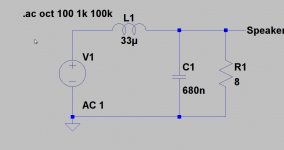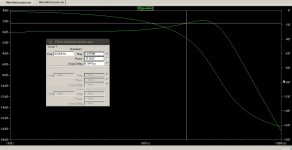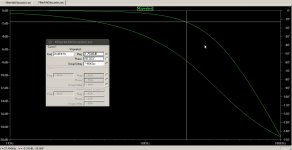Hi Nigel,
I agree that it is possible to solve it reasonably good.
But that's not at all the normal situation in class D these days.
Let's have a look to a real life filter as attached with values that are not exotic.
In case of 8R the signal will be boosted more than 1.6db at 20kHz.
In case of 4R the signal will be defeated more than 1.7db at 20kHz.
Obviously many output filters will affect the frequency response in a non neglectible way.
Furtheron the difference of 3.4db between 4R and 8R tells that the tweeter is driven with a pretty high impedance. Effective Z is in the range of multiple Ohms. Means a damping factor far below 10.
I am not at all a damping factor fetishist, but such low values simply do not ensure voltage drive for the tweeter.
Someone might now say that speakers are not purely resisitive.
True. But better don't hope that correct equivalent circuits of real speakers would cure things.
Of course the behavior can be improved by higher fs and a faster filter and also by post filter feedback, but there are many designs out there which show similar short comings as the attached simulation.
I agree that it is possible to solve it reasonably good.
But that's not at all the normal situation in class D these days.
Let's have a look to a real life filter as attached with values that are not exotic.
In case of 8R the signal will be boosted more than 1.6db at 20kHz.
In case of 4R the signal will be defeated more than 1.7db at 20kHz.
Obviously many output filters will affect the frequency response in a non neglectible way.
Furtheron the difference of 3.4db between 4R and 8R tells that the tweeter is driven with a pretty high impedance. Effective Z is in the range of multiple Ohms. Means a damping factor far below 10.
I am not at all a damping factor fetishist, but such low values simply do not ensure voltage drive for the tweeter.
Someone might now say that speakers are not purely resisitive.
True. But better don't hope that correct equivalent circuits of real speakers would cure things.
Of course the behavior can be improved by higher fs and a faster filter and also by post filter feedback, but there are many designs out there which show similar short comings as the attached simulation.
Attachments
IcePower amps have very high damping factors, so I don't think it's a class-d problem.
At what frequency ? ;-)
But I agree with you that it isn't a general class-d problem but depending on how a class-d amp is designed. Although they can be built chaply in terms of the parts used, designing them is quite difficult.
The damping factor at high frequencies is definitley determined by the NFB loop and the output filter properties and not the PSU.
But there were a lot of class-d amps around with aenemic bass due to the use of weak PSUs.
Regards
Charles
Simply boosting the switching frequency higher will give you a nice AM broadcast amplifier and a whole new set of problems, or so I've heard.
Because of this i've decided to only use class D amps where circumstances allow for ultra short speaker wires, such as active applications. Using a class D amp with normal, long speaker cables changes the sound of other equipment in my room and not for the better.
Hi all,
There are certainly some good and bad class D amps out there. But there are topologies / PCB designs that adress the problems with the output filter, EMC, load dependant behavier, ...
I think Bruno Putzeys pretty much nailed it: http://www.hypex.nl/docs/papers/ncore wp.pdf
There are certainly some good and bad class D amps out there. But there are topologies / PCB designs that adress the problems with the output filter, EMC, load dependant behavier, ...
I think Bruno Putzeys pretty much nailed it: http://www.hypex.nl/docs/papers/ncore wp.pdf
The fact that there are multiple ways to milden class D specific issues does not mean that the issues are gone.
All error mechanisms which need special care in classD to avoid substantial inferior performance than classAB are class D related issues.
- Modulator distortion
- Dead time distortion (some analogies to cross over distortion, but not the same. Not at all!)
- Slowish output filter
- Naturally low PSRR of the switching stage
- Parametrization of feedback loop is another animal
- Clipping recovery
- Carrier aliasing or frequency drop at high modulation levels
- .. ..
..
Each of the topics above can be a fun killer if not solved with special care.
And only few designs these days take care of all that in a reasonably balanced way. And even in designs of higher quality often there is a massive optimization of just very few points, while accepting unpleasant impact on others. That's the best fundament for a successful marketing story, which highlights a few exceptional good properties and doesn't tell the short comings.
To me the key for a good amp design is an overall well balanced performance.
It is up to everybody to judge on his own, whether a shown design is promoted with a very narrow set of properties or with a set properties that covers very various situations.
Finally the link from all to the numbers to our ears is hard to predict and listening has to be the final criteria.
All error mechanisms which need special care in classD to avoid substantial inferior performance than classAB are class D related issues.
- Modulator distortion
- Dead time distortion (some analogies to cross over distortion, but not the same. Not at all!)
- Slowish output filter
- Naturally low PSRR of the switching stage
- Parametrization of feedback loop is another animal
- Clipping recovery
- Carrier aliasing or frequency drop at high modulation levels
- ..
 ..
..Each of the topics above can be a fun killer if not solved with special care.
And only few designs these days take care of all that in a reasonably balanced way. And even in designs of higher quality often there is a massive optimization of just very few points, while accepting unpleasant impact on others. That's the best fundament for a successful marketing story, which highlights a few exceptional good properties and doesn't tell the short comings.
To me the key for a good amp design is an overall well balanced performance.
It is up to everybody to judge on his own, whether a shown design is promoted with a very narrow set of properties or with a set properties that covers very various situations.
Finally the link from all to the numbers to our ears is hard to predict and listening has to be the final criteria.
That's a very good question and I do not have a good answer for it! It may be in the spec sheets, I think it is. How much does damping factor matter in the midrange and highs?At what frequency ? ;-)
The fact that there are multiple ways to milden class D specific issues does not mean that the issues are gone.
All error mechanisms which need special care in classD to avoid substantial inferior performance than classAB are class D related issues.
- Modulator distortion
- Dead time distortion (some analogies to cross over distortion, but not the same. Not at all!)
- Slowish output filter
- Naturally low PSRR of the switching stage
- Parametrization of feedback loop is another animal
- Clipping recovery
- Carrier aliasing or frequency drop at high modulation levels
- ....
Each of the topics above can be a fun killer if not solved with special care.
And only few designs these days take care of all that in a reasonably balanced way. And even in designs of higher quality often there is a massive optimization of just very few points, while accepting unpleasant impact on others. That's the best fundament for a successful marketing story, which highlights a few exceptional good properties and doesn't tell the short comings.
To me the key for a good amp design is an overall well balanced performance.
It is up to everybody to judge on his own, whether a shown design is promoted with a very narrow set of properties or with a set properties that covers very various situations.
Finally the link from all to the numbers to our ears is hard to predict and listening has to be the final criteria.
Very technical and beyond me for this but interesting reading..
I completely decide on the equipment I want to own by listening to it..
It's hard to understand that theres other ways to decide?
Once and while, yes. But since 2007 I stepped into class D for curiosity.Chocoholic, do you design other classes of Solid State Amps?
Listening is definitely the key question to decide about liking or disliking HiFi equipment.
But as always when you learned about the insights of a technology, judgement will also take into account the technical beauty or uglyness.
I'll have to check out class D again sometime.. Problem is Stereo shops just connect a pile of popular name brand components together.. Their goal is to sell by name alone..
I can't find where Courtice is. Google puts it as a street.
But I will have my TPA3116 at the Toronto diy meet tomorrow.
If you are interested and can spare the time post here to get on the list:
http://www.diyaudio.com/forums/clubs-events/212618-greater-toronto-area-diy-meetup-23.html
I was running it last night and had enough punch on the bass and enough "air".
It seemed to depend on source material. Bring your own ipod or equivalent and see how it sounds to you.
I can't find where Courtice is. Google puts it as a street.
But I will have my TPA3116 at the Toronto diy meet tomorrow.
If you are interested and can spare the time post here to get on the list:
http://www.diyaudio.com/forums/clubs-events/212618-greater-toronto-area-diy-meetup-23.html
I was running it last night and had enough punch on the bass and enough "air".
It seemed to depend on source material. Bring your own ipod or equivalent and see how it sounds to you.
I might make it.. I only skimmed through the thread..
Lots of equipment to hear.. Is this how it works
You Say tomorrow Feb 10? Where and what time?
I have small speakers designed by Joe Rasmussen.. I can bring these
Is there gooing to be a decent cd player there
Joel
I can't find where Courtice is. Google puts it as a street.
But I will have my TPA3116 at the Toronto diy meet tomorrow.
Oh Yes and I appreciate the invitation..
Cheers, Joel
Call me crazy but I like Transistor Class AB Amps. There are some great low noise parts out there now and Audio OpAmps have matured. (And Class A when I feel like heating up the house and running up the Electric Bill.) Ha! Ha! To me, big Mosfets are slow switches which are better utilized in power supplies. The Switching Mode Welding Community is still undecided on FETs and Transistors, too; yet a linear transformer still yields the smoothest weld. I'm currently working on a SMPS for a Tube Amp, which will have the "Glass Community" up in arms but I think it's a great application for those those Mosfets that were originally designed and gated to handle current in power supplies with little Drain / Source Resistance; that is where they really shine. I think it's neat that we have so many choices and combinations to play with. What saddens me is the slow vaporization of "Through Hole" parts for us who like to tinker with electrons.
Once and while, yes. But since 2007 I stepped into class D for curiosity.
Listening is definitely the key question to decide about liking or disliking HiFi equipment.
But as always when you learned about the insights of a technology, judgement will also take into account the technical beauty or uglyness.
My favorite sounding SS amp is Accuphase E202.. Is it partly sound of transistors.. I dont know but would love this integrated DIY new built with out bass treble and all other switches on the front other than volume and I'd be in Solid State Heaven..
Hearing class D is on the agenda for this year..
- Status
- This old topic is closed. If you want to reopen this topic, contact a moderator using the "Report Post" button.
- Home
- Amplifiers
- Class D
- No "AIR" in class D? Yes or No?



